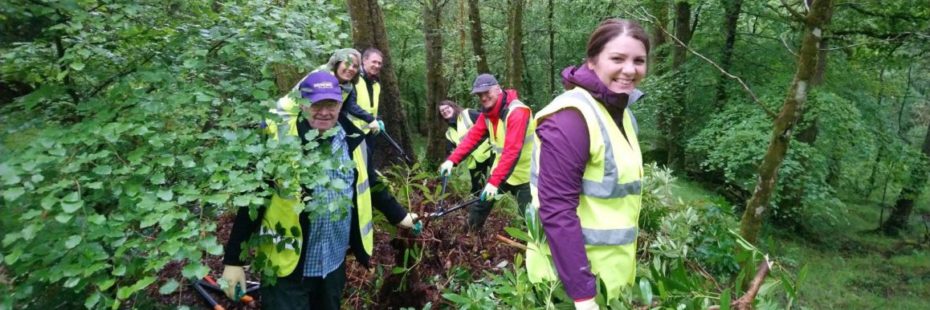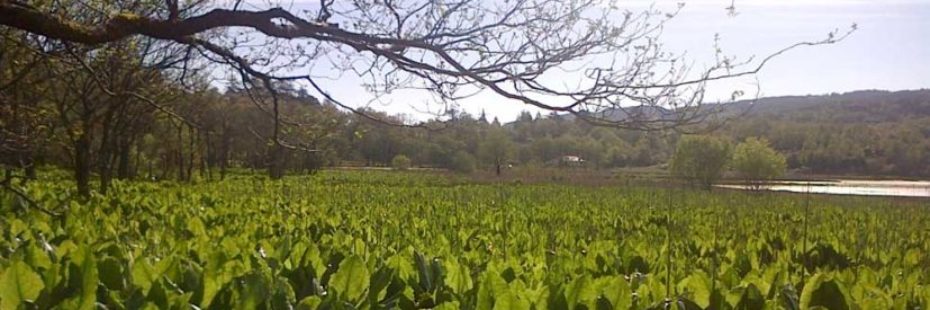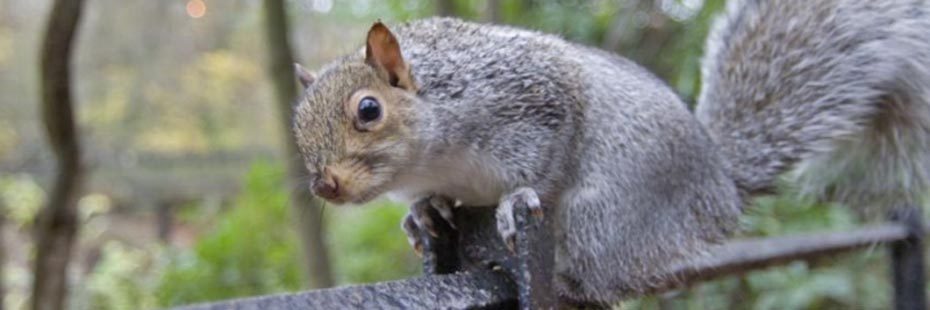
Invasive non-native species
The National Park has several botanical and mammalian invasive non-native species (INNS) which are having an adverse impact on our native biodiversity.
The species that are being targeted for control include:
- Invasive rhododendron
- Riparian: Japanese knotweed, Himalayan balsam, giant hogweed and American skunk cabbage
- Mammalian: Grey squirrel and North American mink
Rhododendron

National Park Board members clearing invasive rhododendron
The presence of invasive rhododendron is a major cause of designated native woodlands being classified as in unfavourable condition within the National Park – there are 35 designated sites (some of them overlapping, i.e. SSSIs and SACs) with designated features that are affected by invasive species. Ten[1] of them have rhododendron present that affects the favourable status of the site.
Rhododendron, if left untreated, can inhibit the growth of all vegetation growing beneath its canopy, and eventually out-compete nearly all native tree and shrub regeneration. It casts dense shade and produces poor quality leaf litter, impacting on water quality and reducing invertebrate abundance. Re-colonisation with native species after removal of rhododendron is slow, resulting in a loss of native biodiversity and therefore the value of the woodland.
The NWSS in 2014, stated that the National Park had 5,787 ha of native woodland, with an estimated 7% (396 ha) being adversely affected by the presence of rhododendron. This may seem a small percentage, however, the task is a large and difficult one and key to controlling rhododendron is colony scale control which is co-ordinated, if required, over multiple land holdings.
Objectives by 2023
- Active management of Rhododendron in all ten designated sites by 2023.
- Expand control of rhododendron to create a buffer zone to protect all areas under current active management, such as designated sites.
- All sites within the National Forest Estate will remain in active management.
- The National Park Authority and partners will identify priorities and opportunities for control programmes on a landscape scale, through both grant funding and officer time.
- Work with partners, such as PlantLife, to monitor control sites that will produce data on clearance and habitat restoration that can be used by land managers to inform future management.
- Ensure all long-term forest plans detail management of invasive rhododendron in line with the Forestry Commission Scotland publication.
[1] Ben A’an and Brenachoile Woods, Boturich Woodlands, Craig Royston Woods, Cuilvona and Craigmore Woods, Fairy Knowe and Doon Hill, Glen Loin, Inchlonaig, Inchtavannach and Inchconnachan, Stronvar Marshes, and Trossachs Woods
Riparian INNS

American skunk cabbage
The presence of invasive non-native species (INNS) within any habitat can reduce ecological connectivity due to the robust, structural growth of many INNS and the possibility of disturbance and spread.
The removal of INNS allows smaller native plants to recolonise including grasses, ferns and flowering plants. Re-colonisation of native species will result in an increase in native biodiversity and has the potential to encourage the expansion of vulnerable native species.
This working group aims to prevent, monitor and control the introduction, spread and extent of INNS that affect the riparian zones of the rivers and lochs in a sustainable manner on a catchment-wide scale. The focus will concentrate primarily on the control of invasive non-native plants: Giant hogweed, Japanese knotweed, Himalayan balsam and American skunk cabbage. Coordination will be included where overlap with the rhododendron working group occurs in the riparian zones.
It is recognised that complete eradication of INNS may not be attainable due to the high risk of re-infestations. The strategy is to manage INNS so that they do not severely affect the riparian corridor of the National Park’s water courses.
Objectives by 2023
- Reduce riparian INNS that negatively affect habitats in the National Park along with active control of any spread, prioritising designated sites.
- Develop control programmes at a catchment level to remove known riparian INNS from the Upper Tay, Upper Forth, Teith, Loch Lomond, Endrick, Loch Eck and Loch Goil catchments, and ensure management of contamination downstream.
- Continue to use agreed monitoring and recording process which will also report on indicators of success.
- Work with land managers, fishery trusts, government agencies, communities and volunteers to reduce the extent and damaging impact of these species and, wherever possible, remove them completely.
- Develop rapid response measures for removal and control to any new outbreaks of riparian INNS.
- Train volunteers and land managers involved in projects to control riparian INNS.
- Raise awareness of how to avoid spreading riparian INNS through both formal and informal education.
- Work with partners to keep up–to-date records of known INNS locations.
- Map the locations of INNS and use treatment and survey data.
- Devise an overarching Riparian INNS strategy with agreed criteria for prioritising treatment of non-native riparian INNS plants within the NP, both the geographic areas to be prioritised first and the species to be prioritised within each catchment or sub catchment.
Mammalian INNS

Grey squirrel
Non-native animals are having a significant negative impact on our native ecosystems, being responsible for the decline of native species by direct predation, carrying diseases and viruses to which our native species have no resilience and out-competing our native species. In combination with direct control of the mammalian non-native species we want to undertake habitat restoration that will encourage the return of our native wildlife.
The work that is being carried out in the National Park complements the Scottish Invasive Species Initiative (SISI) which is led by Scottish Natural Heritage (SNH) and is funded by the Heritage Lottery Fund, SNH and by in-kind support from project partners and volunteers. This initiative is a four-year partnership project set up to tackle invasive non-native species alongside rivers and watercourses in northern Scotland.
The working group will concentrate primarily on the control of invasive non-native animal species – grey squirrel and North American mink, which will have beneficial results to the red squirrel and water vole populations, respectively.
Objectives by 2023
- Reduce the population and re-colonisation of grey squirrel and North American mink in the National Park through a network of community-led groups and land managers continuing responsible trapping efforts in vulnerable areas.
- Retain effective grey squirrel and mink control in areas where populations have declined to ensure densities do not regain.
- Involve land managers and local communities in the reporting of INNS species.
- Continue to promote recording of squirrel sightings through SWT
- Increase the presence of water voles found during annual surveys.
- Improve habitats from native species, such as better connected native woodlands and more naturalised water courses.
- Provide information on responsible land management to encourage land managers to have good forest and riparian management that benefits native species, such as creating water bodies, reducing bank side poaching, planting the correct tree species etc.
- Collaborate with partners to deliver native mammal conservation education throughout the National Park through public events, interpretation, social media etc.
- Increase volunteer involvement in surveys.
- Continue and increase collaboration with land managers to reduce the presence of mammalian INNS but also to improve habitats to favour native species.
- Increase numbers of active volunteers (monitoring and control).

